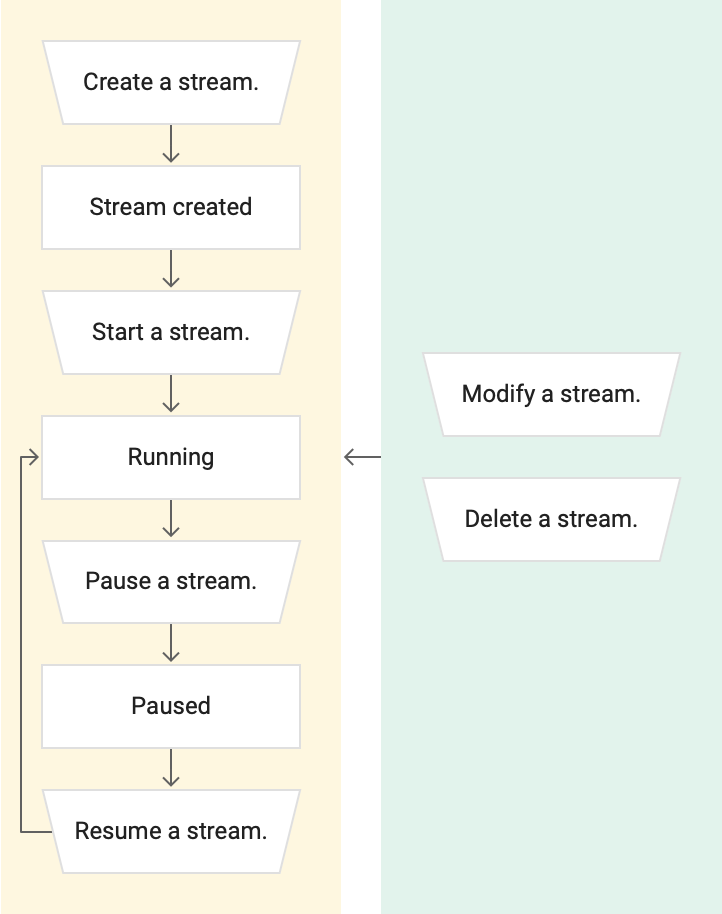Diagram berikut menunjukkan berbagai status dan transisi dalam siklus proses streaming.

Pertama, Anda membuat streaming. Datastream menggunakan aliran ini untuk mentransfer data dari database sumber ke tujuan. Setelah streaming dibuat, status streaming adalah Not started.
Setelah membuat streaming, Anda memulainya. Status streaming akan berubah menjadi Starting. Hal ini menandakan bahwa aliran data sedang dalam proses dimulai dan divalidasi.
- Jika streaming valid, status streaming akan berubah dari
StartingmenjadiRunning. - Jika streaming tidak valid, status streaming akan berubah dari
Startingkembali menjadiNot started. Kemudian, Anda dapat memperbaiki masalah streaming. Misalnya, jika error terkait dengan informasi konektivitas aliran, ubah definisi aliran. Setelah mengatasi semua masalah streaming, mulai lagi streaming, dan status akan berubah menjadiStarting, lalu menjadiRunning.
Anda dapat menjeda streaming. Saat aliran data dijeda, Datastream tidak akan menarik data baru dari database sumber ke tujuan. Namun, beberapa data mungkin terus ditulis ke tujuan karena data dalam proses terus mengalir.
Oleh karena itu, setelah Anda menjeda streaming, status streaming akan berubah dari Running menjadi Draining. Menguras aliran adalah proses mengosongkan aliran sehingga tidak berisi data apa pun. Setelah semua data dalam aliran dikosongkan, status aliran akan berubah dari Draining menjadi Paused.
Saat Anda melanjutkan streaming yang dijeda, status streaming akan berubah dari Paused menjadi Running.
Ada dua tindakan yang dapat Anda lakukan kapan saja selama siklus proses streaming:
- Ubah aliran data. Setiap perubahan yang Anda buat akan langsung diterapkan.
- Hapus streaming setelah Anda tidak lagi memerlukannya.
Error streaming
Streaming yang sedang berjalan dapat mengalami error yang dapat menyebabkan streaming mengubah statusnya menjadi Failed atau Failed permanently:
- Status
Failedberarti bahwa streaming mengalami error yang dapat dipulihkan. Artinya, streaming masih aktif, atau terus berupaya berjalan. - Streaming
Failed permanentlyadalah streaming yang mengalami error yang tidak dapat dipulihkan sehingga tidak dapat terus berjalan. Error tersebut dapat menyebabkan kehilangan data.
Anda dapat mengatasi masalah untuk aliran Failed, dan aliran akan otomatis dilanjutkan. Statusnya berubah dari Failed kembali menjadi Running. Untuk mengetahui informasi selengkapnya, lihat Memecahkan masalah streaming.
Anda dapat memulihkan aliran Failed permanently secara manual. Untuk mengetahui informasi selengkapnya, lihat Memulihkan streaming.
Langkah berikutnya
- Untuk mengetahui informasi tentang cara menjalankan streaming, lihat Menjalankan streaming.
- Untuk mengetahui informasi tentang cara mengubah streaming, lihat Mengubah streaming.
- Untuk mengetahui informasi tentang cara memecahkan masalah streaming, lihat Memecahkan masalah streaming.
- Untuk mengetahui informasi tentang cara memulihkan streaming, lihat Memulihkan streaming.
- Untuk mengetahui informasi tentang cara menghapus aliran, lihat Menghapus aliran.

